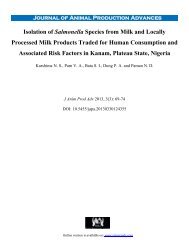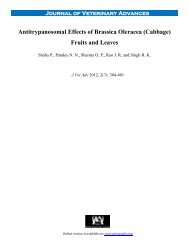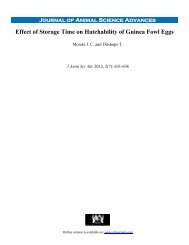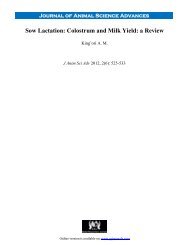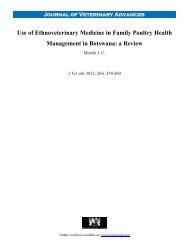PDF Download
PDF Download
PDF Download
You also want an ePaper? Increase the reach of your titles
YUMPU automatically turns print PDFs into web optimized ePapers that Google loves.
Journal of Animal Production Advances<br />
Cold Active β-Galactosidase of Hafnia Alvei KNOUC302<br />
Isolated from Raw Milk: Identification of the Bacteria,<br />
Cloning Partial Gene of β-Galactosidase in Escherichia Coli<br />
Nam E. S. and Ahn J. K.<br />
J Anim Prod Adv 2012, 2(2): 101-108<br />
Online version is available on: www.grjournals.com
ISSN: 2251-7677<br />
NAM AND AHN<br />
Original article<br />
Cold Active β-Galactosidase of Hafnia Alvei<br />
KNOUC302 Isolated from Raw Milk: Identification<br />
of the Bacteria, Cloning Partial Gene of β-<br />
Galactosidase in Escherichia Coli<br />
1 Nam E. S. and *2 Ahn J. K.<br />
1 Sogang-Binggrae Food Advanced Analysis Center, Sogang University, Seoul 121-742, Republic of Korea<br />
2 Department of Agricultural Sciences, Korea National Open University, Seoul 110-791, Republic of Korea<br />
Abstract<br />
Psychrophilic bacteria producing lactose hydrolyzing enzyme were isolated from the samples of raw milk<br />
collected from dairy farms of Kyung-gi province in Korea. Among isolated strains, KNOUC302 showing the<br />
best activity of lactose hydrolysis was identified, and its β-galactosidase gene was cloned. This strain was<br />
aerobic, asporogenic bacilli, immobile, Gram negative, catalase positive and oxidase positive. It grew optimally<br />
at 20 ºC and pH=7.0-7.2. The composition of major fatty acids in the cell membrane of KNOUC 302, were C 12:0<br />
(10.2 %), C 14:0 3OH (25.41 %), C 16:0 (9.94 %) and C 16:1 ω 7 c (29.75 %). Based on morphological and biochemical<br />
properties, the strain could be identified as Hafnia sp. and finally as Hafnia alvei by phylogenetic analysis based<br />
on 16S rDNA sequence. A part of β-galactosidase gene, 779 bp, coding 296 a.a from N-terminal of the β-<br />
galactosidase was isolated from Hafnia alvei KNOUC302 by partial digestion of chromosomal DNA with<br />
Sau3AI and cloned in E. coli Top 10F’. The incomplete gene of 779 bp was supplemented, from vector during<br />
cloning, with 109 bp nucleotides providing terminal codon to a complete ORF (KNOUC302 β-gal). The gene<br />
(KNOUC302 β-gal) consists of 918 bp encoding the protein of 306 amino acids and 34,806 Da of deduced Mw.<br />
Key words: Psychrophilic, β-galactosidase gene, Hafnia alvei, cloning<br />
* Corresponding author: ajk@knou.ac.kr<br />
Received on: 06 Jan 2012<br />
Revised on: 26 Jan 2012<br />
Accepted on: 29 Jan 2012<br />
Online Published on: 01 Feb 2012<br />
101 J. Anim. Prod. Adv., 2012, 2(2):
COLD ACTIVE β–GALACTOSIDASE OF HAFNIA ALVEI KNOUC302 ISOLATED FROM …<br />
Introduction<br />
Psychrophiles exhibiting optimal growth at low<br />
temperature (1) produce cold-adapted enzymes,<br />
which exhibit high catalytic activities at low<br />
temperature to adapt to cold habitats, and thus,<br />
psychrophiles have attracted attention as sources of<br />
enzymes with potential for low-temperature<br />
catalysis (2). Many psychrophiles were reported to<br />
produce variety of cold-active enzymes useful in<br />
food processing, biomass conversion, molecular<br />
biology, environmental biosensors, bioremediation,<br />
cleaning of contact lense, and several other<br />
processes (3-7).<br />
In particular, cold active enzymes are attractive<br />
in food industry for the processing of fruit juices<br />
and milk, because there is an increasing industrial<br />
trend to treat food stuffs under mild conditions to<br />
avoid spoilage, changes in taste and nutritional<br />
values at ambient temperature, and because coldactive<br />
enzymes can be inactivated at moderate<br />
temperatures without harsh heating treatment (8, 9).<br />
Among cold-active enzymes, β-galactosidase<br />
(EC.3.2.1.23), which hydrolyzes lactose to glucose<br />
and galactose, is one of the important foodindustrial<br />
enzymes. It can be used to degrade<br />
lactose for several purposes; e.g., (1) removal of<br />
lactose from refrigerated milk for people who are<br />
lactose intolerant, (2) conversion of lactose to<br />
glucose and galactose, which are more fermentable<br />
sugars than lactose, and (3) removal of lactose from<br />
pollutants of dairy industry (10).<br />
There have been many reports on cold active β-<br />
galactosidase from psychrotrophic bacteria of<br />
Arthrobacter psychrolactophilus (11),<br />
Carnobacterium pisciocola BA (12) and<br />
Pseudoalteromonas haloplakis (2), Planococcus<br />
(13), and a psychotropic yeast of Guehomyces<br />
pullulans (7). The genes coding cold active β-<br />
galactosidase have been detected in Arthrobacter<br />
sp. (14), Carnobacterium sp. (12) and Planococcus<br />
sp. (13). However there has not been a useful one<br />
yet for application in milk processing and further<br />
research is required to find a proper one for<br />
practical use.<br />
We isolated a psychrophilic bacteria, Hafnia<br />
alvei, producing β-galactosidase, cloned gene of the<br />
enzyme in E. coli, and the results are being<br />
reported.<br />
Materials and Methods<br />
Screening and cultivation condition<br />
Raw milk samples produced at dairy farms of<br />
Northern Kyunggi province in Korea were used for<br />
isolation of psychrophilic bacteria hydrolysing<br />
ONPG and lactose. Milk sample was enriched in the<br />
Brain heart infusion broth (BHI; Difco<br />
Laboratories, Detroit, Mich) containing 1 % (w/v)<br />
lactose, and incubated at 4 ºC aerobically by<br />
shaking (200 rpm) for 30 days, and spread on BHI<br />
agar containing 1 % (w/v) lactose, and 0.01 % (w/v)<br />
5-bromo-4-chloro-3-indolyl-β-D-galactopyranoside<br />
(X-gal; Duchefa Biochemei, Holland). After<br />
incubation at 15 ºC for 3 days, blue colonies were<br />
selected, and then cultivated in Brain heart infusion<br />
broth and agar for determining β-galactosidase<br />
activity and identification.<br />
Assay of β-galactosidase activity<br />
β-galactosidase activity was determined by<br />
measuring the hydrolysis of o-nitrophenyl -Dgalactopyranoside<br />
(ONPG; Sigma) as the substrate<br />
by the procedure presented by Miller (15). An<br />
aliquot of cell free extracts (0.5 mL) was added to<br />
2.5 mL of ONPG solution (0.04 M, in Na-phosphate<br />
buffer of 0.01 M and pH 6.8) and incubated at 4 ºC<br />
for 2 hrs. The reaction was stopped by addition of 3<br />
mL of 0.5 M Na 2 CO 3 and the absorbance at 420 nm<br />
was measured. One unit of enzyme activity is<br />
defined as the activity hydrolyzing 1μmol of ONPG<br />
per min by cell free extract from 1 mL of culture<br />
cell whose A 600 was adjusted to 8.0. Hydrolysis of<br />
lactose was measured by glucose detection kit<br />
(Glucose B-test Wako; Wako Pure Chemicals<br />
Industries, Ltd, Osaka, Japan). 0.04 mL of cell free<br />
extracts was added to 1.6 mL of skim milk, and<br />
incubated for 5 days at 4 ºC. One unit of activity for<br />
hydrolysis of lactose was defined as the amount of<br />
enzyme producing 1 μmol of glucose per day by 1<br />
mL of cell culture whose A 600 was 8.0.<br />
Morphological and biochemical<br />
characterization of microorganism<br />
Among isolated strains, the strain showing the<br />
highest β-galactosidase activity was identified by<br />
102 J. Anim. Prod. Adv., 2012, 2(2):101-108
Gram staining, morphological, biochemical, and<br />
physiological tests. Cell was grown on BHI agar to<br />
determine optimum growth condition for<br />
temperature (5-40 ºC) and in BHI broth for pH(4.0-<br />
8.0). pH of BHI broth was adjusted with HCl or<br />
NaOH. Acid production from carbohydrate, and<br />
utilization of sole carbon sources were determined<br />
using API tests (BioMerieux), including API 20E<br />
(identification system for Enterobacteriaceae and<br />
other Gram-negative rods) and API 20NE<br />
(identification system for gram-negative nonenterobacterial<br />
rods) galleries.<br />
Analysis of cellular fatty acid composition<br />
The cell biomass for cellular fatty acid<br />
composition analysis was collected from BHI agar<br />
plates after incubation for 5 days. Cells were<br />
harvested, and the cellular fatty acid was saponified,<br />
methylated and extracted following the instructions<br />
in the manual for Sherlock Microbial Identification<br />
System (MIDI, USA). The fatty acids were<br />
analyzed by gas chromatography (Hewlett Packard<br />
6890, USA) and identified using the Microbial<br />
Identification software package (16).<br />
Determination of 16S rDNA sequence and<br />
phylogenetic analysis<br />
Genomic DNA was isolated, and 16S rDNA<br />
was amplified by PCR and sequenced following the<br />
method described by Rainey et al. (17). Universal<br />
primers of fD1 (5’-GAGTTTGATCCTGGCTCAG-<br />
3’) and rD1 (5’-AGAAAGGAGGTGATCCAGCC-<br />
3’) were used for PCR. PCR products were purified<br />
by ethanol precipitation and electrophoresis with a<br />
model 377 Genetic Analyzer (Perkin-Elmer Co.).<br />
The 16S rDNA sequence was aligned against the<br />
previously determined sequences in Ribosomal<br />
Data of GenBank. The phylogenetic tree for the<br />
dataset was inferred using the neighbor-joining<br />
method (18).<br />
Assaying effect of temperature and pH on the<br />
β-galactosidase activity<br />
Effect of temperature on β-galactosidase<br />
produced in cell free extracts of KNOUC 302 was<br />
analyzed by measuring the enzyme activity at<br />
various temperatures (4 to 60 ºC) in 0.01 M sodium<br />
phosphate buffer (pH 6.8). Optimum pH for the β-<br />
galactosidase activity was determined by measuring<br />
the activity at various pHs(4.6 to 9.6) at 4 ºC in<br />
103 J. Anim. Prod. Adv., 2012, 2(2):<br />
NAM AND AHN<br />
sodium acetated buffer (0.01 M, pH 4.25-pH 6.0)<br />
and sodium phosphate buffer (0.01 M, pH 6.0-pH<br />
7.68). Enzyme stability was determined by<br />
measuring the residual activity during incubation of<br />
cell free extracts of KNOUC302 in sodium<br />
phosphate buffer (0.01 M, pH6.8) at 4 ºC and 37 ºC<br />
for 7 days.<br />
Cloning and sequence determination of β-<br />
galactosidase gene<br />
The chromosomal DNA of strain KNOUC302<br />
cells was isolated using a Genomic DNA Prep Kit<br />
(A&A Biotechnology, Poland) according to the<br />
protocol for gram-negative bacteria. The DNA was<br />
partially digested using Sau3A1 endonuclease, and<br />
4-10 kb fragments were collected and purified after<br />
electrophoresis in 0.8 % agarose gel using the DNA<br />
Gel Out Kit (A&A Biotechnology, Poland). To<br />
prepare genomic library, these DNA fragments<br />
were ligated into BamH1 site in pRSET (Promega,<br />
USA), transformed to E. coli TOP10F’ and<br />
incubated at 15 ºC for 3 days on LB agar containing<br />
100 ug ampicillin/mL, 100 ug/mL X-Gal without<br />
addition of IPTG. Colony was randomly taken for<br />
analysis. Sequence of the cloned DNA fragment<br />
was determined using Big Dye Automatic<br />
sequencer ABI 377 (Perkin Elmer, USA) and<br />
PE9600 Thermocycler (Perkin Elmer, USA).<br />
Results and Discussion<br />
Isolation and identification of bacterium<br />
producing cold-active β-galactosidase<br />
From raw milk samples collected from dairy<br />
farms of Northern Kyunggi province in Korea. 11<br />
strains having the activity of X-gal hydrolysis at 4<br />
ºC were isolated and KNOUC302 showed a good<br />
activity of ONPG hydrolysis and the highest<br />
activity of lactose hydrolysis (Table 1). Strain<br />
KNOUC302 was chosen, and it’s 16S rDNA,<br />
morphological and biochemical properties were<br />
examined for identification. The 16S rDNA of<br />
strain KNOUC302 was composed of 1,498bp<br />
(GenBank accession No. JN014467). BLAST<br />
searching revealed the highest similarity of 16S<br />
rDNA of strain KNOUC302 with those of<br />
Obesumbacterium proteus DSM 2777 T (98.9%<br />
identity) and Hafnia alvei ATCC 13337 T (99.8%<br />
identity) in phylogenetic tree (Fig. 1).<br />
Obesumbacterium sp. and Hafnia alvei are closely
COLD ACTIVE β–GALACTOSIDASE OF HAFNIA ALVEI KNOUC302 ISOLATED FROM …<br />
related to each other (19). However<br />
Obesumbacterium has different shape of long<br />
pleomorphic rod with that of Hafnia forming<br />
uniformly rod shape (20), and most strains of<br />
Obesumbacterium ferment only D-mannose and<br />
trehalose, rarely other carbohydrates including<br />
lactose (21, 22).<br />
Table 1: Hydrolysis of ONPG and lactose of isolated<br />
strains from raw milk<br />
No. Strain No.<br />
Hydrolysis of<br />
ONPG 1) Lactose 2)<br />
1 KNOUC301 0.024 N.D<br />
2 KNOUC302 0.530 28.073<br />
3 KNOUC303 0.770 N.D<br />
4 KNOUC304 0.557 14.194<br />
5 KNOUC305 1.087 3.943<br />
6 KNOUC306 1.407 N.D<br />
7 KNOUC307 1.118 18.932<br />
8 KNOUC308 1.098 N.D<br />
9 KNOUC309 0.533 N.D<br />
10 KNOUC310 0.309 N.D<br />
11 KNOUC311 0.425 N.D<br />
1)<br />
One unit of enzyme activity is defined as the activity<br />
hydrolyzing 1μmol of ONPG per min by cell free extract from<br />
1ml of culture whose A 600 is 8.<br />
2) One unit of enzyme activity is the one hydrolyzing 1μmol of<br />
lactose per day at 4℃ by cell free extracts from 1ml of culture<br />
whose A 600 is 8.<br />
acids of Hafnia alvei α773 were reported to be C 16:0 ,<br />
C 16:1 , C 17:0 and 18:1 (24). Though cellular fatty acids<br />
composition of KNOUC 302 does not completely<br />
coincide with those of Hafnia alvei α773, the<br />
morphological and biochemical properties of<br />
KNOUC302 are matching well to the result of<br />
phylogenetic analysis presenting that strain<br />
KNOUC is genetically close to Hafnia alvei ATCC<br />
13337. Therefore, strain KNOUC302 would be the<br />
species Hafnia alvei. We finally identified<br />
KNOUC302 as Hafnia alvei, and named the strain<br />
as Hafnia alvei KNOUC302.<br />
Effect of temperature and pH on β-<br />
galactosidase in cell free extract of KNOUC302<br />
The selected strain, KNOUC302 was tested on<br />
optimum temperature and pH, and stability for its β-<br />
galactosidase in crude cell extracts. The optimal<br />
temperature and pH of strain KNOUC302 β-<br />
galactosidase in cell free extracts was 15 ºC and<br />
pH7.5 (Fig. 2). The β-galactosidase retended 80%<br />
activity of optimum temperature at 4 ºC and 10 ºC<br />
and 60 % activity of optimum pH at pH of milk (pH<br />
6.8). Stability of the β-galactosidase was examined<br />
by incubating at 4 ºC and 37 ºC for 7 days. The β-<br />
galactosidase was stable at 4 ºC for 7 days, but its<br />
activity decreased to less than 60 % of initial<br />
activity in 7 days at 37 ºC(Fig. 2). The properties of<br />
KNOUC302 β-galactosidase are satisfying the<br />
requirements for hydrolysis of lactase in milk at low<br />
temperature. Psychrotrophic bacteria, Planococcus<br />
sp. L4 (25) and Arthrobacter sp. (26, 27) produced<br />
β-galactosidase whose optimum temperature and<br />
optimum pH were 20 ºC and pH 6.8, and 10-15 ºC<br />
and pH 8 respectively. However other<br />
psychrotrophic bacteria, Arthrobacter<br />
psychrolactophilus (11), Carnobacterium pisciocola<br />
BA (12), Pseudoalteromonas haloplakis (2) and<br />
Planococcus sp. (13) produced β-galactosidase<br />
reacting optimally at high temperature of 40 ºC, 30<br />
ºC, 45 ºC and 42 ºC respectively. The β-<br />
galactosidase of Arthrobacter psychrolactophilus<br />
(11), Pseudoalteromonas haloplakis (2) and<br />
Planococcus sp. (13) reacted optimally at pH 7.2,<br />
pH 6.4, pH 8 and pH 6.4 respectively. Optimum<br />
temperature and pH of β-Galactosidase of<br />
Enterobacter cloacae, belonging to the same family<br />
with strain KNOUC 302 were 50 ºC and pH 9.0<br />
(27).<br />
As in Table 2 presenting morphological<br />
biochemical properties, the strain KNOUC302 was<br />
Gram negative, rod, nonsporing, facultative<br />
anaerobic, oxidase negative, and reduced nitrate to<br />
nitrite. These properties classify KNOUC302 as<br />
family Enterobacteriaceae (22), and uniformly red<br />
shape of KNOUN302 and utilization of many<br />
carbohydrates by KNOUC302 let KNOUC302 be<br />
out of genus Obesumbacterium. KNOUC302 failed<br />
in production of indole and H 2 S, and was negative<br />
in fermentation of raffinose, sorbitol, and inositol<br />
that are the typical characteristics of Genus Hafnia<br />
(23). And KNOUC302 showed negativity in indole<br />
production and urease, and positivity in hydrolysis<br />
of PNPG and ONPG that are fitting to species<br />
Hafnia alvei (21, 23). The main fatty acids of<br />
KNOUC 302 cell were C 12:0, C 14:0 3-OH, C 16:0 and<br />
C 16:1 ω 7 c comprising 10.2 %, 25.41 %, 9.94 % and<br />
29.75 % respectively (Table 3). The main fatty<br />
104 J. Anim. Prod. Adv., 2012, 2(2):101-108
NAM AND AHN<br />
Table 2: Morphological and biochemical properties of the strain KNOUC 302<br />
Characteristics Reaction Characteristics Reaction<br />
Gram staining<br />
Shape<br />
Motility<br />
Spore formation<br />
Oxidation-fermentation<br />
Optimum temp.<br />
Optimum pH<br />
Growth at 5℃<br />
37℃<br />
Catalase<br />
Oxidase<br />
Hydrolysis of PNPG<br />
ONPG<br />
Nitrate reduction<br />
Indol production<br />
H2S formation<br />
Citrate utilization<br />
Urease<br />
β-Hemolysis<br />
MacConkey<br />
Utilization of D-glucose<br />
Mannitol<br />
-<br />
Rod<br />
-<br />
-<br />
O/F<br />
20℃<br />
6.8~7.2<br />
+<br />
-<br />
+<br />
-<br />
+<br />
+<br />
+<br />
-<br />
-<br />
-<br />
-<br />
-<br />
+<br />
+<br />
+<br />
Maltose<br />
Rhamnose<br />
Sucrose<br />
Mannose<br />
Galactose<br />
Gelatin<br />
Lactose<br />
Fructose<br />
Xylitol<br />
Ducitol<br />
Adonitol<br />
Raffinose<br />
Glycerol<br />
Erythrol<br />
Acetylglucosamine<br />
Starch<br />
Amigdalin<br />
Tagatose<br />
Sorbitol<br />
Xylose<br />
Arabinose<br />
+<br />
+<br />
-<br />
+<br />
-<br />
-<br />
+<br />
-<br />
-<br />
+<br />
-<br />
-<br />
-<br />
-<br />
+<br />
-<br />
-<br />
+<br />
-<br />
+<br />
+<br />
Presumptive identification<br />
Hafnia sp.<br />
+, positive reaction; -, negative reaction<br />
66.0<br />
80.7<br />
0.01<br />
98.5<br />
99.9<br />
100<br />
Obesumbacterium proteus DSM 2777 T (AJ233422)<br />
Hafnia alvei ATCC 13337 T (M59155)<br />
KNOUC302<br />
Yersinia pestis D-28 (X75274)<br />
Rahnella aquatica DSM 4594 T (AJ233426)<br />
Serratia marcescens DSM 30121 T (AJ233431)<br />
Serratia rubidaea DSM 4480 T (AJ233436)<br />
Erwinia amylovora DSM 30165 T (AJ233410)<br />
Klebsiella pneumoniae DSM 30104 T (AJ233420)<br />
Citrobacter freundii DSM 30039 T (AJ233408)<br />
Pectobacterium carotovorum DSM 30168 T (AJ233411)<br />
Pectobacterium cacticidum LMG 17936 T (AJ223409)<br />
Brenneria salicis DSM 30166 T (AJ233419)<br />
Vibrio cholerae CECT 514 T (X76337)<br />
Fig. 1: Phylogenetic tree based on 16S rDNA sequences showing the positions of strain KNOUC302, the representative<br />
of some other related taxa. Bootstrap values (1000replicatioons) are shown as percentage at each node only if they are 50<br />
% greater. Scale bar represents 0.01 substitutions per nucleotide position.<br />
105 J. Anim. Prod. Adv., 2012, 2(2):
Residual activity(%)<br />
Relative activity(%)<br />
Relative activity (%)<br />
COLD ACTIVE β–GALACTOSIDASE OF HAFNIA ALVEI KNOUC302 ISOLATED FROM …<br />
Cloning β-galactosidase gene of strain<br />
KNOUC302 in E. coli<br />
In the prepared genomic library, there was a<br />
colony having the vector harboring an ORF coding<br />
a protein of β-galactosidase. The ORF is composed<br />
of 888 bp encoding 295 amino acids whose deduced<br />
Mw is 33,709 Da (Fig. 3). But the ORF is not a<br />
complete β-galactosidase gene of Hafnia alvei<br />
KNOUC302. The front sequence of 779 bp,<br />
beginning from initial codon, was from<br />
chromosome of Hafnia alvei KNOUC302, and the<br />
rear sequence of 109 bp to terminal codon was from<br />
vector (pRSET). The nucleotide was named as<br />
KNOUC302 β-gal. A BLAST search in the<br />
databases of NCBI revealed that the 779 bp front<br />
sequence of KNOUC302 β-gal coded the amino<br />
terminal of β-galactosidase belonging to glycoside<br />
hydrolase family 2. The front 779 bp sequence of<br />
KNOUC302 β-gal, from chromosome of Hafnia<br />
alvei KNOUC302, showed the following identities<br />
to β-galactosidase genes from microorganisms of<br />
family Enterobacteriaceae: Escherichia coli K12<br />
(297/401, 74 %, GenBank Accession No.<br />
AP009378), Rahnella sp. Y9602 (364/485, 75 %,<br />
GenBank Accession No. CP002505), Serratia<br />
proteamaculans 568(311/409, 76 %, GenBank<br />
Accession No. CP000826) and Enterobacter<br />
aerogenes KCTC2190 (289/388, 74 %, GenBank<br />
Accession No. CP002824).<br />
galactosidase of Arthrobacter sp. 32c (29),<br />
Pseudoalteromonas haloplanktis (2) and<br />
Planococcus sp. L4 (25) were 2085 bp, 3117 bp and<br />
2031 bp respectively.<br />
100<br />
80<br />
60<br />
40<br />
20<br />
0<br />
0 10 20 30 40<br />
100<br />
80<br />
60<br />
40<br />
20<br />
120<br />
100<br />
Temp.<br />
0<br />
4 5 6 7 8<br />
pH<br />
Table 3: Composition of major fatty acids of strain<br />
KNOUC302<br />
Fatty acid Contents (%)<br />
C 12:0 10.20<br />
C 14:0 6.31<br />
C 14:0 3OH 25.41<br />
C 16:1 ω 7 c 29.75<br />
C 16:0 9.94<br />
C 18:1 ω 7 c 5.05<br />
The size of β-galactosidase genes from Escherichia<br />
coli K12 (GenBank Accession No. AP009378),<br />
Rahnella sp. Y9602 (GenBank Accession No.<br />
CP002505), Serratia proteamaculans 568(GenBank<br />
Accession No. CP000826) and Enterobacter<br />
aerogenes KCTC2190 (GenBank Accession No.<br />
CP002824) were 3075 bp, 3099 bp, 3090 bp and<br />
3108 bp respectively. Genes encoding cold active β-<br />
0<br />
0 1 2 4 7<br />
Fig. 2: Effects of temperature (A) and pH (B) on the<br />
activity, and stability (C) of β-galactosidase in cell free<br />
extracts of Hafnia alvei KNOUC302.<br />
* Effect of temperature was tested in Na-phosphate buffer<br />
(0.01 M, pH= 6.8).<br />
* Effect of pH was examined in Na-acetate (0.01 M) for<br />
pH=4.25 to 6.0, and in Na-phosphate buffer (0.01 M) for pH<br />
6.0 to 7.68 at 4 ℃.<br />
* Values are means of triplicates ± S.D.<br />
106 J. Anim. Prod. Adv., 2012, 2(2):101-108<br />
80<br />
60<br />
40<br />
20<br />
Days
NAM AND AHN<br />
Conclusion<br />
In this study, Hafnia alvei KNOUC302, a strain<br />
that produces lactose hydrolyzing enzyme at low<br />
temperature, was isolated from the samples of raw<br />
milk collected from dairy farms of Kyung-gi<br />
province in Korea. The results obtained in this study<br />
show that Hafnia alvei KNOUC302 grew optimally<br />
at 20 ºC and pH=7.0-7.2. The gene (KNOUC302 β-<br />
gal) consists of 918 bp encoding the protein of 306<br />
amino acids and 34,806 Da of deduced Mw. In the<br />
search for cold-adapted β-galactosidase, we<br />
conclude that the β-D-galactosidase from Hafnia<br />
alvei KNOUC302 is a cold-active enzyme, and that<br />
the enzyme could have advantageous applications in<br />
the food industry, the treatment of chilled dairy<br />
products while avoiding flavor tainting and the risk<br />
of microbial contamination.<br />
References<br />
Fig. 3: DNA sequence of Hafnia alvei KNOUC302 β-<br />
galactosidase gene (KNOUC302β-gal) and deduced<br />
amino acid sequence.<br />
*The fragment from pRSET vector came from pRSET C,<br />
cloning vector.<br />
Bondarenko VM, Afanas’eva SM, Vasiurenko ZP (1982).<br />
Heterogeneity of the fatty acid composition of bacteria in<br />
the genera Klebsiella, Enterobacter, Hafnia and Serratia.<br />
Zurnal mikrobiologii I immunobiologii., 12 : 54-60.<br />
Brenner DJ, Farmer JJ (2005). Family I. Enterobacteriaceae.<br />
In: Bergey’s Manual of Systematic Bacteriology, Vol. 2,<br />
D.J. Brenner, N.R. Krieg, J.T. Staley(Eds.), Williams &<br />
Wilkins, Baltimore pp. 587-607.<br />
Coombs JM, Brenchley JE (1999). Biochemical and<br />
phylogenetic analyses of a cold-active β-galactosidase<br />
from the lactic acid bacterium Carnobacterium piscicola<br />
BA, Appl. Environ. Microbiol., 65 : 5443-5450.<br />
Farmer JJ, Brenner DJ (2005). Genus XXII.<br />
Obesumbacterium. In: Bergey’s Manual of Systematic<br />
Bacteriology, Vol. 2, D.J. Brenner, N.R Krieg, J.T. Staley<br />
(Eds.), Williams &Wilkins, Baltimore pp. 710-713.<br />
Feller G, Narinx E, Arpigny JL, Aittaleb M, Baise E, Genicot<br />
S, Gerday C (1996). Enzymes from psychrophilic<br />
organisms. FEMS Microbiol. Rev., 18: 189-202.<br />
Ghatak A, Guha AK, Ray L (2010). β-D-Galactosidase from<br />
Enterobacter cloacae: production and some<br />
physicochemical properties. Appl. Biochem. Biotechnol.,<br />
165 : 1678-1688.<br />
Gerday C, Aittaleb M, Bentahir M, Chessa JP, Claverie P,<br />
Collins T, D’Amico SM, Dumont J, Garsoux G, Georlette<br />
D, Hoyoux AT, Lonhienne T, Meuwiw, MA, Feller G<br />
(2000). Cold-adapted enzymes from fundamentals to<br />
biotechnology. Trends in Biotechnol., 18 : 103-107.<br />
Gutshall KR, Trimbur DE, Kasmir JJ, Brenchley JE (1995).<br />
Analysis of a novel gene and β-galactosidase isoenzyme<br />
from a psychrophilic Arthrobacter isolate. J. Bacteriol.,<br />
177 : 1981-1988.<br />
Hildebrandt P, Wanarska M, Kur J (2009). A new coldadapted<br />
β-D-galactosidase from the Antarctic Arthrobacter<br />
107 J. Anim. Prod. Adv., 2012, 2(2):
COLD ACTIVE β–GALACTOSIDASE OF HAFNIA ALVEI KNOUC302 ISOLATED FROM …<br />
sp. 32c-gene cloning, overexpression, purification and<br />
properties. BMC Microbiol., 9 : 151-162.<br />
Holt JG, Krieg NR, Sneath PH, Staley JT, Williams ST<br />
(1994). Group 5 Facultatively anaerobic Gram negative<br />
rods, In: Bergey’s Manual of Determinative Bacteriology,<br />
Williams & Wilkins, Baltimore pp. 175-289.<br />
Hoyoux A, Jennes I, Dubiose P, Genicot S, Dubaik P,<br />
Francoi, JM (2001). Cold-adapted β-galactosidase from the<br />
Antarctic psychrophile Pseudoalteromonas haloplanktis.<br />
Appl. Environ. Microbiol., 67 : 1529-1535.<br />
Hu JM, Li H, Cao LX, Wu PC, Zhang PC, Sang SI, Zhang<br />
XY, Chen MJ, Lu JQ, Liu YH (2007). Molecular cloning<br />
and characterization of the gene encoding cold-active betagalatosidase<br />
from a psychtrophic and halotolerant<br />
Planococcus sp. L4. J. Agri. Food Chem., 55 : 2217-2224.<br />
Loveland J, Gutshall K, Kasmie J, Prema P, Brenchley JE<br />
(1994). Characterization of psychotropic microorganism<br />
production β-galactosidase activities. Appl. Environ.<br />
Microbiol., 60(1) : 12-18.<br />
Margesin R, Schinner F (1994). Properties of cold-adapted<br />
microorganisms and their potential role in biotechnology.<br />
J. Biotechnol., 33 : 1-14.<br />
Marshall CJ (1997). Cold-adapted enzymes, Trend in<br />
Biotechnol., 15 : 359-364.<br />
Miller JH (1972). Experiments in molecular genetics. In: Cold<br />
Spring Harbor Laboratory, Cold Spring Harber, N.Y.<br />
Morita RY (1975). Psychrophilic bacteria. Bacteriol. Rev., 39<br />
: 144-167.<br />
Nakagawa T, Fujimoto Y, Ikehata R (2006a). Purification and<br />
molecular characterization of cold-active β-galactosidase<br />
from Arthrobacter psychrolactophilus strains F2. Appl.<br />
Microbiol. Biotechnol. 72 : 720-725.<br />
Nakagawa T, Fujimoto Y, Uchino M (2003). Isolation and<br />
characterization of psychrophiles producing cold-active β-<br />
galactosidase. Lett. Appl. Microbiol., 37 : 154-157.<br />
Nakagawa T, Ikehata R, Uchino M, Miyaji T, Takano K,<br />
Tomizuka N (2006b). Cold-active β-galactosidase activity<br />
of isolated psychrophilic-basido mycetous yeast<br />
Guehomyces pullulans, Microbio. Res., 161 : 75-79.<br />
Priest FG, Somerville HJ, Cole JA, Hough JS (1973). The<br />
taxonomic position of Obesumbacterium proteus, a<br />
common brewery contaminant. J. Gen. Microbiol., 75 :<br />
295-307.<br />
Rainey FA, Ward-Rainey N, Kroppenstedt RM, Stackebrandt<br />
E (1996). The genus Nocardiopsis represents a<br />
phylogenetically coherent taxon and a distinct<br />
actinomycete lineage: proposal of Nocardiopsacease fam.<br />
Nov, Int. Syst. Bacteriol., 46 : 1088-1092.<br />
Russell NJ (1998). Molecular adaptations in psychrophilic<br />
bacteria: potential for biotechnological applications. Adv.<br />
Biochem. Engineering Biotechnol., 61 : 1-21.<br />
Saitou N, Nei M (1987) The neighbor-joining method: a new<br />
method for reconstruction phylogenetic trees. Mol. Biol.<br />
Evol., 4 : 406-424.<br />
Sakazaki R (2005). Genus XV. Hafnia. In: Bergey’s Manual<br />
of Systematic Bacteriology Vol. 2, D.J. Brenner, N.R.<br />
Krieg, J.T. Staley (Eds.), Williams & Wilkins, Baltimore<br />
pp. 681-685.<br />
Sasser M (1990). Identification of bacteria by gas<br />
chromatography of cellular fatty acids. MIDI Technical<br />
Note No.101. Newark. DE: MIDI Inc., USA.<br />
Sheridan PP, Brenchley JE (2000). Characterization of a salttolerant<br />
family 42 β-galactosidase from a psychrophilic<br />
Antarctic Planococcus isolate, Appl. Environ. Microbiol.<br />
66 : 2438-2444.<br />
Trimbur DE, Gutshall KR, Prema P, Brenchley JE (1994).<br />
Characterization of a psychrophilic Arthrobacter gene and<br />
its cold-active β-galatosidase, Appl. Environ. Microbiol.,<br />
60 : 4554-4558.<br />
Xu K, Tang X, Gai Y, Mehmood M, Xiao X, Wang F (2011).<br />
Molecular characterization of cold-inducible β-<br />
galactosidase from Arthrobacter sp. ON14 isolated from<br />
Antarctica. J. Microbiol. Biotechnol., 21 : 236-242.<br />
108 J. Anim. Prod. Adv., 2012, 2(2):101-108





